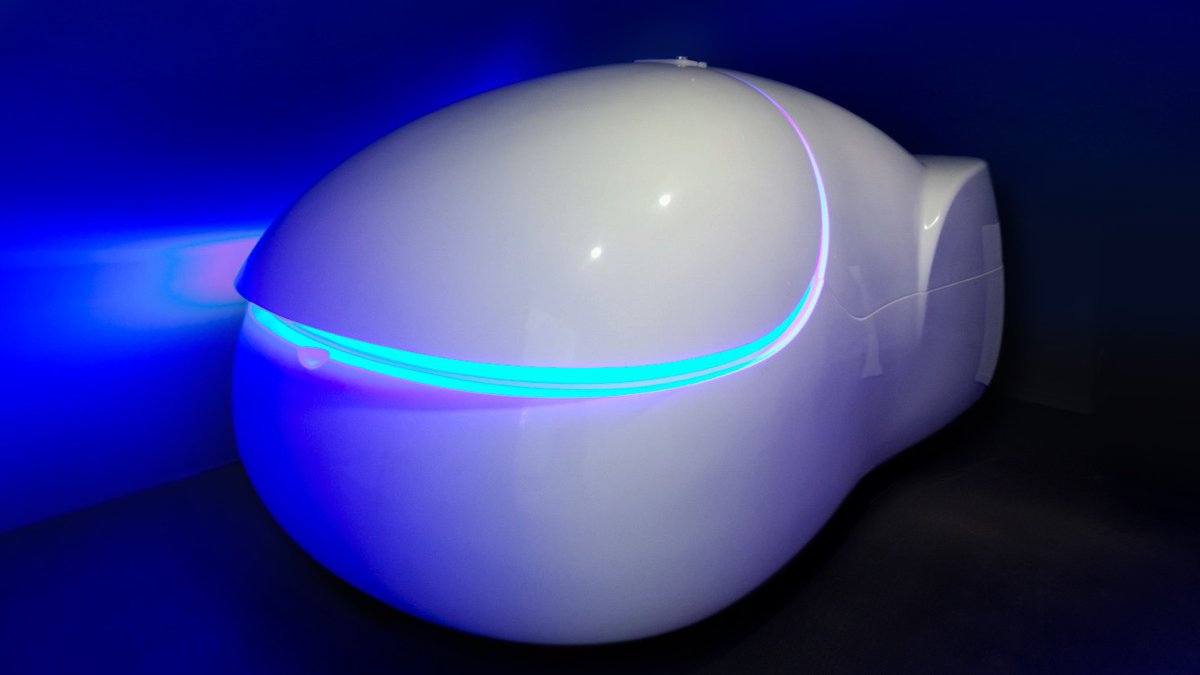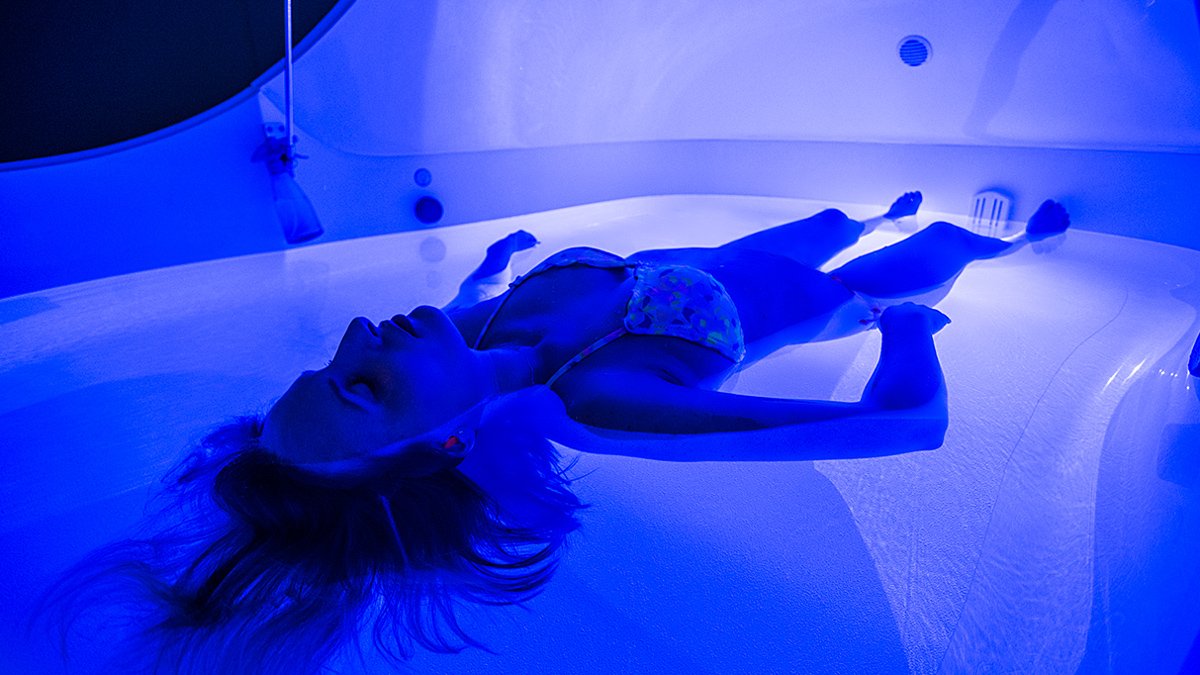Floating is an increasingly popular form of sensory deprivation therapy that involves lying in a pitch black tank of salted water. This may sound like your worst nightmare, but since the invention of Sensory Deprivation Tanks in 1954 they have been praised for their health benefits, particularly in regards to relaxation and stress relief. Here’s what I learned after spending 90 minutes on the inside.
The original purpose of sensory deprivation therapy had little to do with relaxation. Neuroscientist John C. Lilly created the tanks to study the bat shit crazy things the human brain does when it’s left in the dark.
In fact, the original tanks were more reminiscent of Eleven’s experience in Stranger Things than the sleek, modern spa tech we have today. Subjects were suspended in body temperature water with a terrifying ‘Blackout Mask’ strapped to them. No thanks.
Total submersion was eventually replaced with Epsom salt which makes the water so dense that you can simply float on top of it. A far less horrific choice, in my opinion.
Lilly had some interesting things to say about his own alleged experiences in isolation tanks, claiming that it allowed him to interact with inter-dimensional civilisations and creatures. Few others have reported these particular experiences during their floats — and they certainly aren’t advertised on any company websites.
It’s perhaps important to note that Lilly also studied inter-species communication and that there seems to have been a direct correlation between his isolation tank experiments and personal LSD use.
So what do people experience then?
This varies from person to person — many claim hallucinations, out of body experiences and a deep sense of personal introspection. In general, these tend to be reported more acutely by people who have experience with meditation. Studies show that both practises can affect the alpha and theta waves in the brain, so this may not be surprising.
I had no real idea of what to expect during my first float experience, despite my obsessive level of research. I had always wanted to try it for years and finally decided to throw $49 at it on a whim. Would my brain trip balls? Would I reach Enlightenment? Would I just end up singing ‘I Told the Witch Doctor’ in the vein of Homer Simpson? Regardless, I was excited to find out.
After being debriefed by the spa’s expert and taking a pre-float shower I turned out the light, hopped into the tank and gingerly closed the door over. I could still hear relaxing music emanating throughout the room outside, but I was told this would fade within the first five minutes of the float.
So it was just me and my thoughts in a pitch black salt bath. I’m not someone who is particularly comfortable with new situations and generally tries to fill awkward silences with dumb jokes. “Alright brain. You don’t like me and I don’t like you. But let’s just do this and I can get back to killing you with beer,” I said into the void. There was no one there to pretend to laugh at the outdated reference.
 Image: i-sopod
Image: i-sopodSadly, I didn’t experience anything close to a deprivation-induced hallucination throughout my 90 minute session — but I expect this was due to a lack of practise. I also don’t have any experience with meditation (my mind always tends to be chattering away to itself.)
That isn’t to say that it wasn’t a fascinating experience. You don’t have to hallucinate the next White Album to get something out of a float. The first thing I noticed was just how quickly my brain tried to grasp at any form of stimulation. My sense of hearing sharpened in mere minutes — not only did the music outside the tank sound louder (I was convinced that they had accidentally turned it up or that it wasn’t going to fade out at all) but I could my heart beat. I also lost any sense of time almost immediately. I couldn’t tell if it had been two minutes or twenty.
One of the most common things people have asked me about my foray into sensory deprivation has been about claustrophobia; most stating they could never do it for that reason. Fortunately, I feel quite secure in small spaces so this was never a concern for me. But the brain is a funny thing, especially when you’re starving it. Roughly halfway through the session (again, I had no real way of telling how much time had passed) my internal monologue started being a real dick.
“I know the guy said there’s oxygen being pumped in… but the air seems quite dense doesn’t it?” “What if it has broken?”
“I tell you what’s better than enclosed spaces – nice big open ones.”
“Are you sure you can actually breathe properly right now?”
A sudden panic gripped me. Logically I knew that everything was fine, but every other part of me was screaming to open the tank – which you absolutely can do from the inside because it isn’t The Chokey. It took every fibre of my being not to push the door open. I forced myself to focus on my breathing and eventually I calmed the hell down. I’m convinced that this was my brain using every trick in the book to force me to stimulate it.
Perhaps this was the point where my mind admitted defeat, because things got really good after I got a hold of myself. I also managed to find my personal perfect position that stopped me bumping into the sides, which had been really distracting. In fact, my spatial awareness disappeared almost entirely. No more sloshing water to remind me of where I was.
I felt like I was an impossibly straight plank of wood in a form of suspended animation that felt suspiciously like pudding. An insane comparison I know, but that’s the closest I can come to describing it. I was no longer concerned that moving would break the spell – my mind was convinced that I couldn’t actually move anymore. I also couldn’t tell you what I was thinking about anymore. Everything? Nothing? It didn’t really matter. It felt like both mere seconds and several hours passed before the music faded back in and it was all over.
Perhaps the most extraordinary part of the experience was that it didn’t end when the ninety minutes were up. I practically floated down the street when I left and I can’t remember ever feeling more relaxed or at peace with the world. Checking my phone didn’t occur to me until I was halfway back to the station. I also slept incredibly deeply that night and my dreams were more vivid than usual.
I may not have opened a gateway to the Upside Down with my mind this time around, but I definitely experienced some of the alleged benefits of floating. I also suspect that practise will help me reach my own personal Nirvana quicker on subsequent visits. With that in mind, here are a few tips for those of you considering trying it out.
- Avoid Caffeine: I know, most of us are happily enslaved to the foul, nerve sparking mistress that is caffeine. However, it is a stimulant so forgoing that morning cup will make relaxing and switching off a whole lot easier. I would also recommend hydrating the day before so your mind doesn’t try to focus on being thirsty.
- Go to the bathroom beforehand: The last thing you want to do is interrupt your session due to an exploding bladder.
- Remove condensation: Be sure to wipe the condensation off the inside lid before to step into the tank. Droplets hitting the water can be distracting, but more importantly, you do not want that shit dripping into your eyes. It is going to burn and that is not the journey you want to go on.You also want to watch out for this once your session is over — do not sit straight up unless you want the salty water from your forehead running straight into your peepers. Instead, lean your head back as you slowly raise yourself from the water and gently push the water back through your hair.
- Avoid Earplugs: Although most places will offer ear protection I would suggest trying to go without unless you have a personal or medical reason. Your body tries to grasp at any form of sensory stimulation so you may find that it focuses intently on the foreign objects in your ears rather than allowing you to relax.
- Don’t touch your face: At some point your brain will probably try to convince you that you’re itchy – ignore it. It’s just trying to get some of that sweet stimulation. Touching your face with your Epsom-laced fingers is just going to make it itch worse and serve as a distraction. Also, this is just another way to accidentally get salt in your eyes.
- Learn how to meditate: Learning some simple meditation techniques will enable you to quiet your mind faster and get the most out of your float. Obsessing over your uncompleted taxes isn’t the best use of your tank time. Harnessing the art of meditation will also make it easier to control your mind if it tries to wig out halfway through. Show that brain whose boss.
- Find your pose: There’s no real ‘right’ way to lie in the tank, but finding the best pose for you will enable your mind to focus on nothingness rather than whether it’s comfortable or not. I found that it wasn’t until I put my arms by my side, rather than over my head, that I stopped getting distracted by movement.
- Try again: Our brains are used to over stimulation, so don’t be disappointed if it takes time to get used to isolation tanks. The more experience your brain has at shutting out the world the better your future floats will be.
Source: Everything I Learned Inside A Sensory Deprivation Tank | Lifehacker Australia













